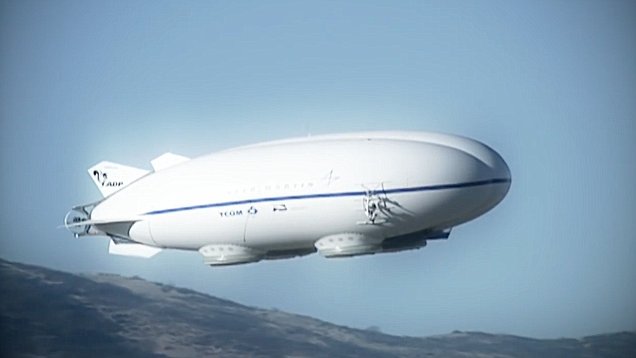The Skunk Works Airship and The American Scientist Who Worked For The Goodyear Zeppelin Division – October 12, 2018

Joe Sutter, Father of The Boeing 747 – October 5, 2018
October 5, 2018
UPS Saves The Boeing 747 – October 19, 2018
October 19, 2018RN3DB
October 12, 2018
Happy Friday,
Today I want to talk about the new and the old. The Skunk Works developed a hybrid airship but the company lost a bid for a $517 million long endurance multi-intelligence vehicle (LEMV) contract, which the army awarded to Northrop Grumman and Hybrid Air Vehicles. Below is a brief article that covers this as well as an interesting article on GoodYear’s Zeppelin program which covers the original airship.
Enjoy…..
The P-791 Hybrid Air Vehicle
Lockheed first flew the P-791 demonstrator five years ago, but the company lost a bid for a $517 million long endurance multi-intelligence vehicle (LEMV) contract, which the army awarded to Northrop Grumman and Hybrid Air Vehicles.
The LEMV program required Northrop to deploy the first aircraft in December to Afghanistan to provide aerial surveillance over 21-day missions, or carry up to 6,900 kg (15,000 lb) of cargo as far as 2,400 nm (4,440 km).
Two months after losing the LEMV contract, Skunk Works officials still predicted a bright future for the P-791. “It’s still in our hangar. It’s available to use again for other demonstrations,” Bob Ruszkowski, a Skunk Works system engineer, said in August. “We’re exploring other opportunities for hybrid airships.”
The first SkyTugs will be designed to lift 20 ton payloads, but future designs could be scaled-up to carry from 50 to several hundred tons of cargo, Purdy says. “We’re creating an industry here,” he adds.
The Golden Age of The
Great Passenger Airships
Mr. Hal Dick graduated from MIT in 1928 and went to work for the Goodyear Tire and Rubber company in 1929; however, he was soon transferred to the Good year-Zeppelin Division, a subsidiary established in the early 1920s by Goodyear’s President Mr. PW Litchfield who had bought the airship patents from Zeppelin on the design of their early airships in the early 1920’s, where he worked with the German engineer brought to the US by Mr. Litchfield and 13 german design engineers who were hired to support the program.
Mr. Dick worked several years on the design, and engineering, of the rigid airships Akron and Macon. The experience gained on this program, along with the fact that he had a dirigible (blimp) pilots license, allowed him to transfer to Germany and work directly with the German airship company, Luftschiffbau Zeppelin, who Goodyear had been sharing their expertise with since purchasing the patents.
(Notice the signature on Mr. Dick’s Dirigible Ballon License is that of Orville Wright)
Mr. Dick worked in Germany from 1934 to 1938 and was the only American to have flown 22 ocean crossings as a crewman on the passenger airships the Graf Zeppelin and the Hiddenburg. Although his status was unofficial, he enjoyed a close working relationship with the German airship company and was provided with information that otherwise could not have been obtained.
Below are a few photos of memorabilia from Hal Dick’s personal collection that he accumulated on his many crossings:
(Boarding Pass from the first transatlantic crossing of the Hindenburg)
(Passenger Manifest from the first transatlantic crossing of the Hindenburg)
(Certificate commemorating Dick’s first crossing of the equator on the Hindenburg, in 1936)
During his time in Germany Dick witnessed the growing influence of Nazism. In 1936 the German air ministry prohibited Dick from collecting further information on an official basis, but because of his friendly relationship with Luftschiffbau Zeppelin personnel, he continued to have free access to the airship plant. Dick was not allowed to take part in the test flights of the newly completed Graf II, and after more restrictions were put in place he left Germany in November, 1938.
Dick was the only man not employed by Luftschiffbau Zeppelin to be aboard the Hindenburg’s first test flight in 1935 and remarkably Dick missed the disastrous last flight of the Hindenburg. Below is an article from a local Kansas paper that details the events of how Hal Dick missed the Hindenburg’s last flight.
All of the information used in this artile I found online. The best place to start looking, if you would like more information, is at the Wichita Sate University Library. There are more bits and pieces out there as well and you can find Mr. Dick’s book, “The Golden Age of the Passenger Airships,” for sale online at Amazon.
Hal Dick’s story is unique and to wrap it up I have included a link to an article I found at the Saturday Evening Post detailing the events of the last flight of the Hindenburg, which I think you will enjoy.
Enjoy the weekend, take care, and fly safe/be safe.
Robert Novell
October 12, 2018






